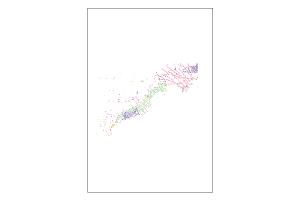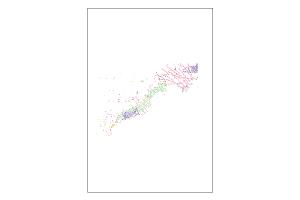gas
Type of resources
Keywords
Publication year
Service types
Topics
-
Australia has significant gas resources capable of meeting the needs of domestic and international consumers for decades. Commercial viability of the resource depends on a number of factors such as geology, infrastructure, resource quality, and water depth. Further exploration is required to bring on Australia's lowest cost gas resources.
-
Although the Canning Basin has yielded minor gas and oil within conventional and unconventional reservoirs, the relatively limited geological data available in this under-explored basin hinder a thorough assessment of its hydrocarbon potential. Knowledge of the Paleozoic Larapintine Petroleum Supersystem is restricted by the scarcity of samples, especially recovered natural gases, which are limited to those collected from recent exploration successes in Ordovician and Permo-Carboniferous successions along the margins of the Fitzroy Trough and Broome Platform. To address this shortcoming, gases trapped within fluid inclusions were analysed from 121 Ordovician to Permian rock samples (encompassing cores, sidewall cores and cuttings) from 70 exploration wells with elevated mud gas readings. The molecular and carbon isotopic compositions of these gases have been integrated with gas compositions derived from open-file sources and recovered gases analysed by Geoscience Australia. Fluid inclusion C1–C5 hydrocarbon gases record a snapshot of the hydrocarbon generation history. Where fluid inclusion gases and recovered gases show similar carbon isotopes, a simple filling history is likely; where they differ, a multicharge history is evident. Since some fluid inclusion gases fall outside the carbon isotopic range of recovered gases, previously unidentified gas systems may have operated in the Canning Basin. Interestingly, the carbon isotopes of the fluid-inclusion heavy wet gases converge with the carbon isotopes of the light oil liquids, indicating potential for gas–oil correlation. A regional geochemical database incorporating these analyses underpins our re-evaluation of gas systems and gas–gas correlations across the basin. <b>Citation:</b> Boreham, C.J., Edwards, D.S., Sohn, J.H., Palatty, P., Chen, J.H. and Mory, A.J., 2020. Gas systems in the onshore Canning Basin as revealed by gas trapped in fluid inclusions. In: Czarnota, K., Roach, I., Abbott, S., Haynes, M., Kositcin, N., Ray, A. and Slatter, E. (eds.) Exploring for the Future: Extended Abstracts, Geoscience Australia, Canberra, 1–4.
-

This is the Acreage Release Marine Environmental Data compiled web service to be updated each year with acreage release. It contains the following publicly available datasets, for the 2016 Acreage Release - Marine Survey Towed-video Transects, Marine Sediments Database Samples, Australian Seascapes, Seabed Mud Content on the Northwest Shelf, Seabed Sand Content of the Northwest Shelf and Seabed Gravel Content of the Northwest Shelf.
-

This is the Acreage Release Marine Environmental Data compiled web service to be updated each year with acreage release. It contains the following publicly available datasets, for the 2016 Acreage Release - Marine Survey Towed-video Transects, Marine Sediments Database Samples, Australian Seascapes, Seabed Mud Content on the Northwest Shelf, Seabed Sand Content of the Northwest Shelf and Seabed Gravel Content of the Northwest Shelf.
-
Recent national and state assessments have concluded that sedimentary formations that underlie or are within the Great Artesian Basin (GAB) may be suitable for the storage of greenhouse gases. These same formations contain methane and naturally generated carbon dioxide that has been trapped for millions of years. The Queensland government has released exploration permits for Greenhouse Gas Storage in the Bowen and Surat basins. An important consideration in assessing the potential economic, environmental, health and safety risks of such projects is the potential impact CO2 migrating out of storage reservoirs could have on overlying groundwater resources. The risk and impact of CO2 migrating from a greenhouse gas storage reservoir into groundwater cannot be objectively assessed without knowledge of the natural baseline characteristics of the groundwater within these systems. Due to the phase behaviour of CO2, geological storage of carbon dioxide in the supercritical state requires depths greater than 800m, but there are no hydrochemical studies of such deeper aquifers in the prospective storage areas. Geoscience Australia (GA) and the Geological Survey of Queensland (GSQ), Queensland Department of Mines and Energy, worked collaboratively under the National Geoscience Agreement (NGA) to characterise the regional hydrochemistry of the Denison Trough and Surat Basin and trialled different groundwater monitoring strategies. The output from this Project constitutes part of a regional baseline reference set for future site-specific and semi-regional monitoring and verification programmes conducted by geological storage proponents. The dataset provides a reference of hydrochemistry for future competing resource users.
-
The Geological and Bioregional Assessments (GBA) Program is a series of independent scientific studies undertaken by Geoscience Australia and the CSIRO, supported by the Bureau of Meteorology, and managed by the Department of Agriculture, Water and the Environment. The Program consists of three stages across three regions with potential to deliver gas to the East Coast Gas Market. Stage 1 was a rapid regional prioritisation conducted by Geoscience Australia, to identify those sedimentary basins with the greatest potential to deliver shale and/or tight gas to the East Coast Gas Market within the next five to ten years. This prioritisation process assessed 27 onshore eastern and northern Australian basins with shale and/or tight gas potential. Further screening reduced this to a shortlist of nine basins where exploration was underway. The shortlisted basins were ranked on a number of criteria. The Cooper Basin, the Beetaloo Sub-basin and the Isa Superbasin were selected for more detailed assessment. Stage 2 of the program involved establishing a baseline understanding of the identified regions. Geoscience Australia produced regional geological evaluations and conceptualisations that inform the assessment of shale and/or tight gas prospectivity, ground- and surface-water impacts, and hydraulic fracturing models. Geoscience Australia’s relative prospectivity assessments provide an indication of where viable petroleum plays are most likely to be present. These data indicate areal and stratigraphic constraints that support the program’s further work in Stage 3, on understanding likely development scenarios, impact assessments, and causal pathways. <b>Citation:</b> Hall Lisa S., Orr Meredith L., Lech Megan E., Lewis Steven, Bailey Adam H. E., Owens Ryan, Bradshaw Barry E., Bernardel George (2021) Geological and Bioregional Assessments: assessing the prospectivity for tight, shale and deep-coal resources in the Cooper Basin, Beetaloo Subbasin and Isa Superbasin. <i>The APPEA Journal</i><b> 61</b>, 477-484. https://doi.org/10.1071/AJ20035
-
The Clarence-Moreton and the Surat basins in Queensland and northern New South Wales contain the coal-bearing sedimentary sequences of the Jurassic Walloon Coal Measures, composed of up to approximately 600 m of mudstone, siltstone, sandstone and coal. In recent years, the intensification of exploration for coal seam gas (CSG) resources within both basins has led to concerns that the depressurisation associated with future resource development may cause adverse impacts on water resources in adjacent aquifers. In order to identify the most suitable tracers to study groundwater recharge and flow patterns within the Walloon Coal Measures and their degree of connectivity with over- or underlying formations, samples were collected from the Walloon Coal Measures and adjacent aquifers in the northern Clarence-Moreton Basin and eastern Surat Basin, and analysed for a wide range of hydrochemical and isotopic parameters. Parameters that were analysed include major ion chemistry, -13C-DIC, -18O, 87Sr/86Sr, Rare Earth Elements (REE), 14C, -2H and -13C of CH4 as well as concentrations of dissolved gases (including methane). Dissolved methane concentrations range from below the reporting limit (10 µg/L) to approximately 50 mg/L in groundwaters of the Walloon Coal Measures. However, the high degree of spatial variability of methane concentrations highlights the general complexity of recharge and groundwater flow processes, especially in the Laidley Sub-Basin of the Clarence-Moreton Basin, where numerous volcanic cones penetrate the Walloon Coal Measures and may form pathways for preferential recharge to the Walloon Coal Measures. Interestingly, dissolved methane was also measured in other sedimentary bedrock units and in alluvial aquifers in areas where no previous CSG exploration or development has occurred, highlighting the natural presence of methane in different aquifers. Radiocarbon ages of Walloon Coal Measure groundwaters are also highly variable, ranging from approximately 2000 yrs BP to >40000 yrs BP. While groundwaters sampled in close proximity to the east and west of the Great Dividing Range are mostly young, suggesting that recharge to the Walloon Coal Measures through the basalts of the Great Dividing Range occurs here, there are otherwise no clearly discernable spatial patterns and no strong correlations with depth or distance along inferred flow paths in the Clarence-Moreton Basin. In contrast to this strong spatial variability of methane concentrations and groundwater ages, REE and 87Sr/86Sr isotope ratios of Walloon Coal Measures groundwaters appear to be very uniform and clearly distinct from groundwaters contained in other bedrock units. This difference is attributed to the different source material of the Walloon Coal Measures (mostly basalts in comparison to other bedrock units which are mostly composed of mineralogical more variable Paleozoic basement rocks of the New England Orogen). This study suggests that REE and 87Sr/86Sr ratios may be a suitable tracer to study hydraulic connectivity of the Walloon Coal Measures with over- or underlying aquifers. In addition, this study also highlights the need to conduct detailed water chemistry and isotope baseline studies prior to the development of coal seam gas resources in order to differentiate between natural background values of methane and potential impacts of coal seam gas development.
-
Bores sunk at Cremorne in 1891 struck coal at approximately 2802 feet. A company was formed to work the coal, but was refused permission to operate at Cremorne. A site at Balmain was secured, and the Birthday Shaft was sunk to a depth of 2,937 feet between 1897 and 1902. This report provides an overview of the occurrence of natural gas and workings for the period 1897 to 1948. Gas yields, commercial production, leakage problems, and the use of testing to determine the behaviour of gas in the mine are the key subjects that are addressed in this report.
-
The Oil and Gas Pipelines service contains known spatial locations of onshore and offshore pipelines or pipeline corridors used to transport natural gas, oil and other liquids within Australia’s mainland and territorial waters.
-
<div>Australia’s Energy Commodity Resources (AECR) provides estimates of Australia’s energy commodity reserves, resources, and production as at the end of 2021. The 2023 edition of AECR also includes previously unpublished energy commodity resource estimates data compiled by Geoscience Australia for the 2021 reporting period. The AECR energy commodity resource estimates are based primarily on published open file data and aggregated (de identified) confidential data. The assessment provides a baseline for the production and remaining recoverable resources of gas, oil, coal, uranium and thorium in Australia, and the global significance of our nation’s energy commodity resources.</div>
